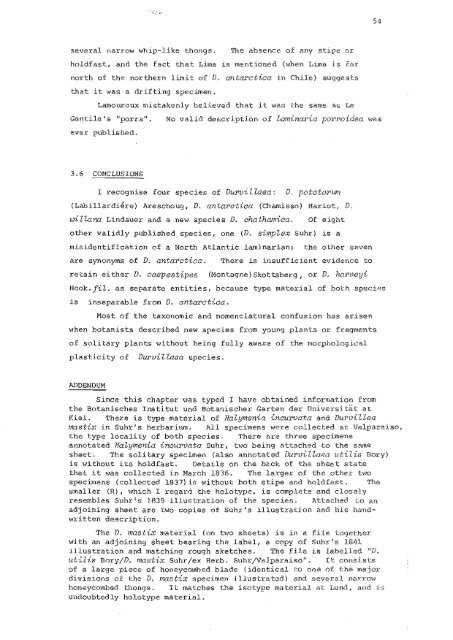A biological study of Durvillaea antarctica (Chamisso) Hariot and D ...
A biological study of Durvillaea antarctica (Chamisso) Hariot and D ...
A biological study of Durvillaea antarctica (Chamisso) Hariot and D ...
You also want an ePaper? Increase the reach of your titles
YUMPU automatically turns print PDFs into web optimized ePapers that Google loves.
54<br />
several narrow whip-like thongs. The absence <strong>of</strong> any stipe or<br />
holdfast, <strong>and</strong> the fact that Lima is mentioned (when Lima is far<br />
north <strong>of</strong> the northern limit <strong>of</strong> D. anta:r'ctica in Chile) suggests<br />
that it was a drifting specbnen.<br />
LamouroWl: mistakenly believed that it wo"s the same as Le<br />
Gentile's "porra". No valid description <strong>of</strong> Laminaria porroidea was<br />
ever published.<br />
3.6 CONCLUSIONS<br />
I :cecognise four species <strong>of</strong> Duroi llaea: D< potatorum<br />
(Labillardiere) Areschoug, D. <strong>antarctica</strong> (<strong>Chamisso</strong>) <strong>Hariot</strong>, D,<br />
willana Lindauer <strong>and</strong> a new species D. chathamica. Of eight<br />
other validly published species, one (D. simplex Suhr) is a<br />
misidentification <strong>of</strong> a North Atlantic laminarian; the other seven<br />
are synonyms <strong>of</strong> D. <strong>antarctica</strong>. There is insufficient evidence to<br />
retain either D. aaepeatipes (Montagne) Skottsberg I or D. hOY'veyi<br />
Hook.fil. as separate entities, because type material <strong>of</strong> both species<br />
is inseparable from D. <strong>antarctica</strong>.<br />
Most <strong>of</strong> the taxonomic <strong>and</strong> nomenclatural confusion has arisen<br />
when botanists described new species from young plants or fragments<br />
<strong>of</strong> solitary plants without being fully aware <strong>of</strong> the morphological<br />
plasticity <strong>of</strong> DurvilZaea species.<br />
ADDENDUM<br />
Since this chapter ~·Jas typed I have obtained infopnation from<br />
the Botanisches Institut und Botanischer Garten der Universi"tat at<br />
Kiel. There is type ma'terial <strong>of</strong> Halymenia inaurvata <strong>and</strong> Dux'viUea<br />
mastix in Suhr's herbarium. All specimens wCY.'e collected at Valparaiso,<br />
the type locality <strong>of</strong> both species. There are three specimens<br />
annotated Halymenia incuY'Vata Suhr, two being attached to the srune<br />
sheet. The solitary specimen (also annotated Du~viZZaea utilis Bory)<br />
is without i"ts holdfast. Details on the ba.ck <strong>of</strong> the sheet state<br />
-that it was collected in March 1836. The laxger <strong>of</strong> the other.: tHO<br />
specimens (collected 1837}is without both stipe <strong>and</strong> hold fast , The<br />
smaller (R), which I regard the holcitype, is complete <strong>and</strong> closely<br />
resembles Suhr's 1839 illustration <strong>of</strong> the species. Attached -to em<br />
adjoining sheet are two copies <strong>of</strong> Suhr's illustration <strong>and</strong> his h<strong>and</strong>written<br />
description.<br />
The D. mastix material (on two sheets) is in ct file -togei:her<br />
with an adjoining sheet bearing the label, a copy <strong>of</strong> Sunr's 1841<br />
illustration <strong>and</strong> matching rough sketches. The file is labelled "D,<br />
utilis Bory/D. mastix Suhr/ex Herb. Suhr/Vi::\lparaiso". It consists<br />
<strong>of</strong> a large piece <strong>of</strong> honeycollibed blade (identical to one <strong>of</strong> the 'major<br />
divisions <strong>of</strong> the D" mastix specimen illustrat8d) aod several nan::m'l<br />
honeycombed thongs" Ii:. matches the iso"type material at Lund, <strong>and</strong> is<br />
undoubted ly holotype material.
















